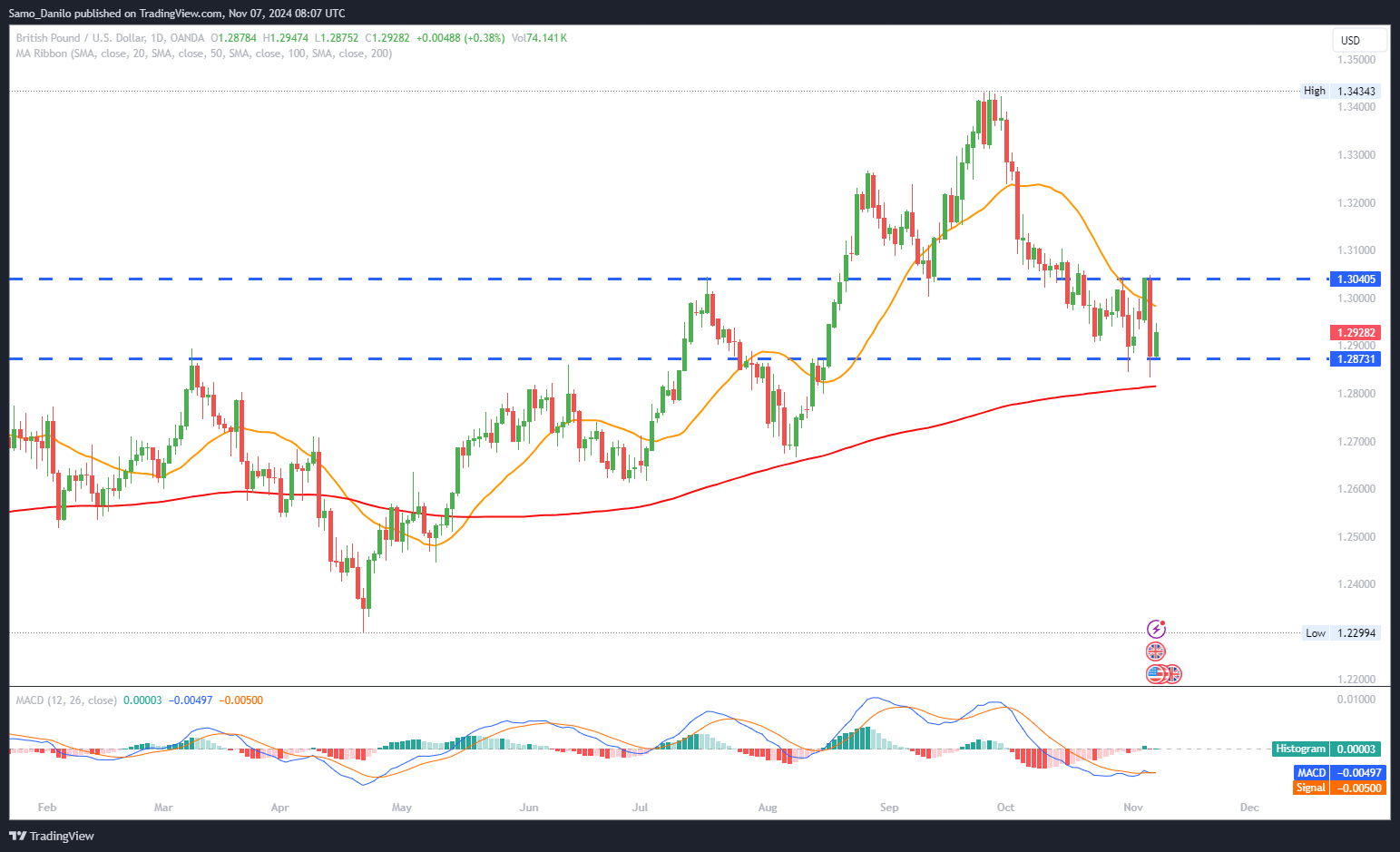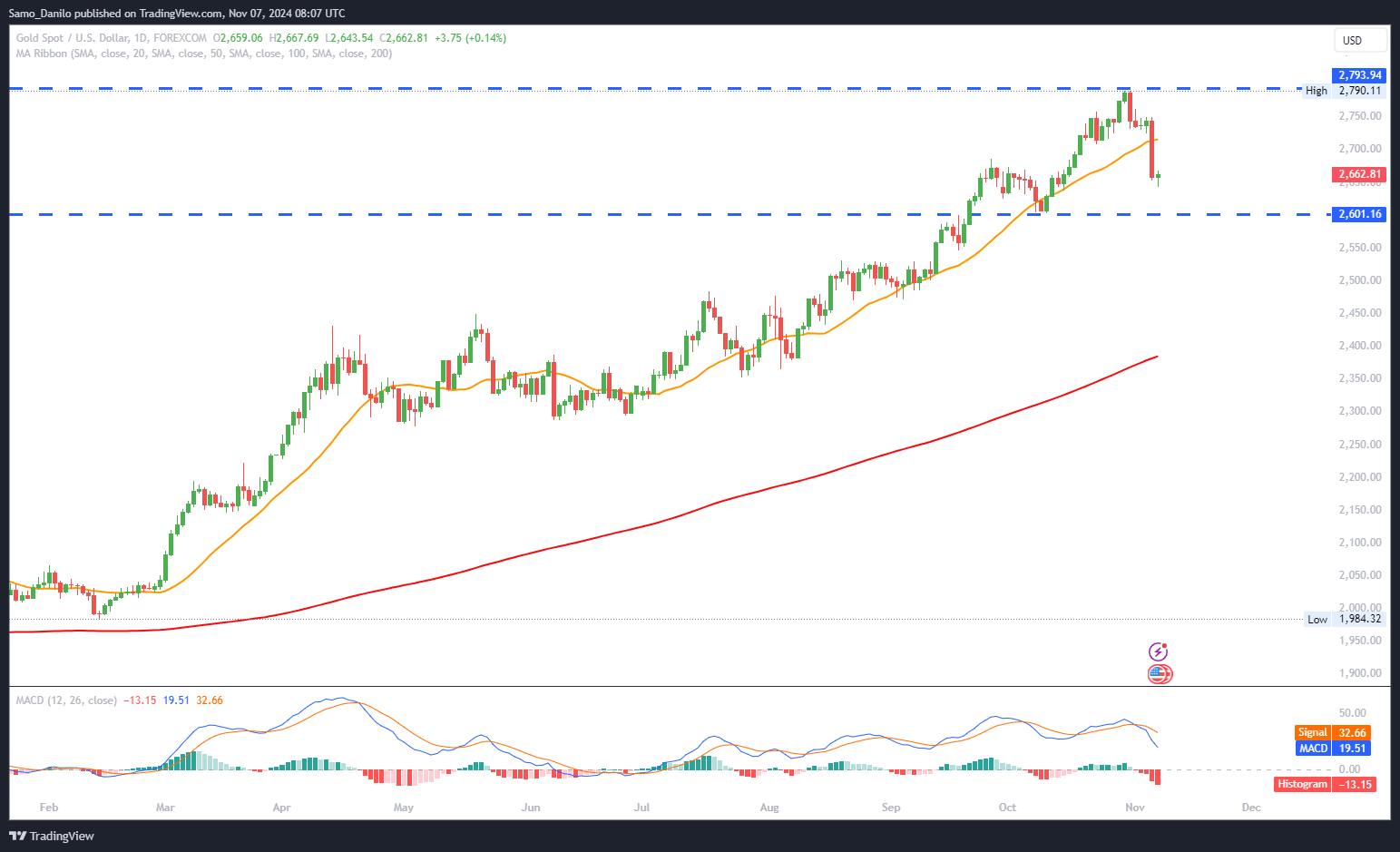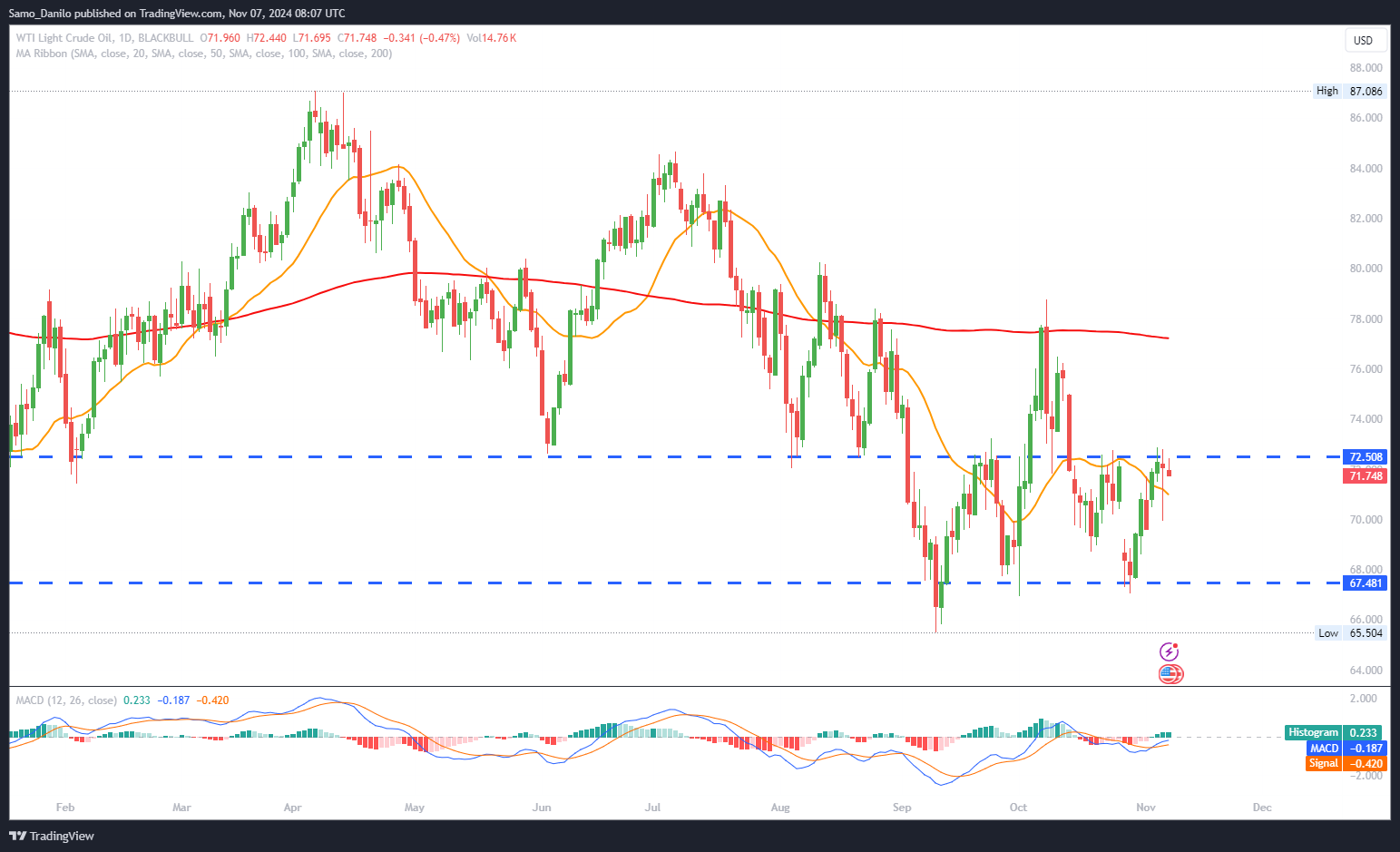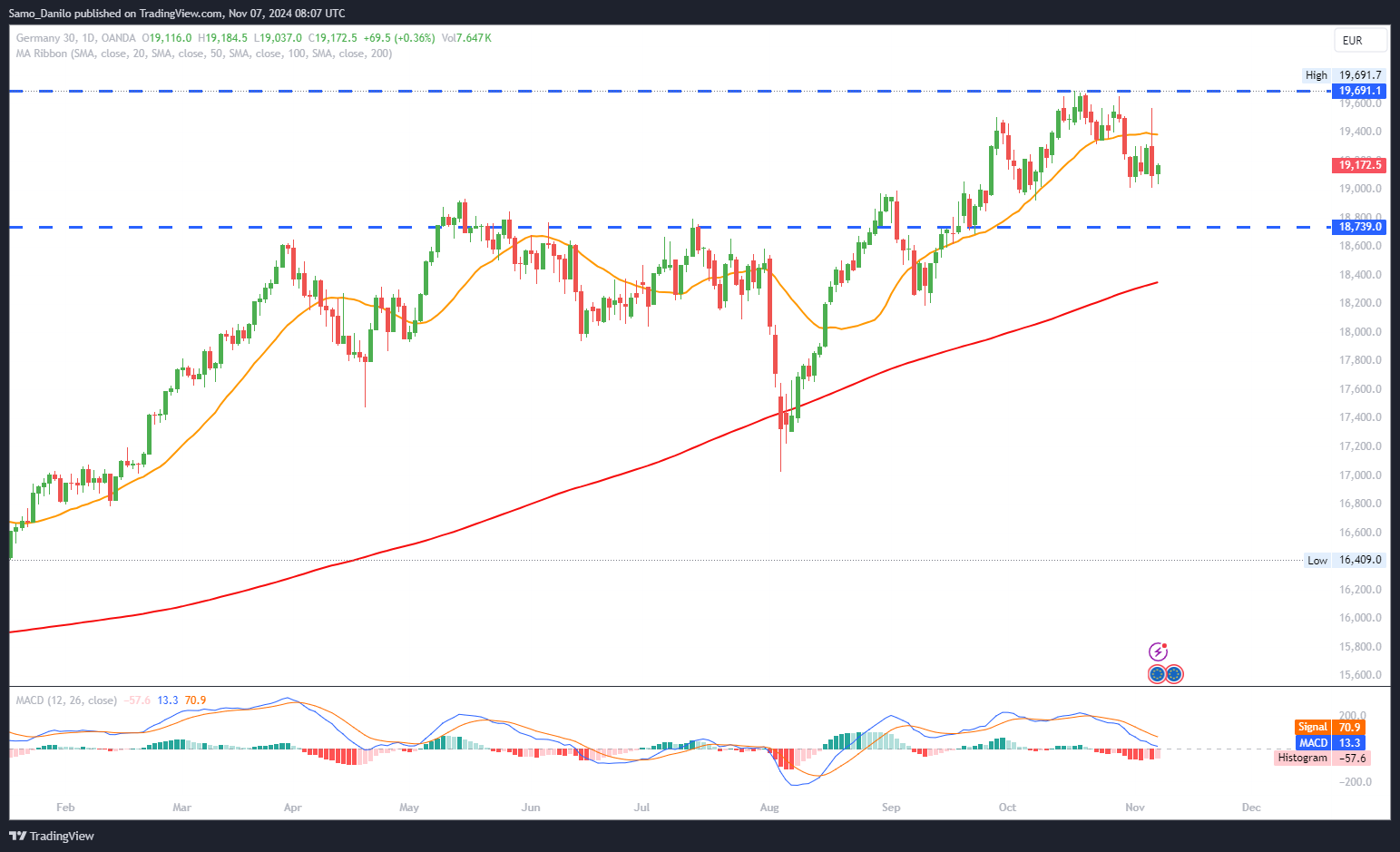EURUSD
- Current Trading Level: The EUR/USD is recovering after a sharp 2% depreciation in the previous session, trading around 1.0760 during Thursday’s European session.
- "Trump Trades": Downside pressure on the EUR/USD pair remains possible as the US Dollar may gain traction from the "Trump trades" driven by the Republican victory in the US election. This political shift could boost the USD as markets anticipate potential tax cuts and tariff policies favorable to the dollar.
- Fed Rate Expectations: The Federal Reserve is expected to announce a 25-basis- point rate cut on Thursday, as signs of softening inflation and a cooling labor market align with expectations of a gradual easing approach by the Fed. This dovish move could momentarily weigh on the dollar, affecting EUR/USD movement.
- Potential ECB Response: If European growth stalls under the pressure of Trump's potential tariffs, the ECB may consider a significant rate cut, possibly reaching near- zero levels by 2025. Such a move would aim to stabilize the economy but would likely put additional downward pressure on the Euro.
- EU Data and ECB Speeches: Pan-EU Retail Sales figures will be released Thursday, followed by the conclusion of the EU leaders’ summit on Friday. Additionally, ECB President Christine Lagarde is scheduled for a follow-up appearance on Saturday, which may offer further insights into the ECB's policy outlook.
Closing statement: The EUR/USD currently faces mixed pressures with a recovery attempt but remains at risk due to the USD’s potential gains on political changes and ECB rate cut expectations tied to economic concerns. Upcoming EU data and ECB commentary will be crucial for the pair’s near-term direction, especially if the Fed confirms anticipated rate cuts.
GBPUSD
- Current Trading Level: GBP/USD is building upward momentum, approaching 1.2950 in Thursday’s European session, rebounding from its lowest level since mid-August as it gains support from a subdued US Dollar.
- BoE Rate Decision: Markets anticipate further easing from the Bank of England (BoE) in its Thursday policy decision. The BoE previously held rates steady at 5.00%, but expectations are building for a dovish shift given the economic backdrop. This anticipation supports GBP/USD in the short term, though clarity on future cuts is limited.
- Mann’s Statements: Catherine Mann has emphasized caution, suggesting that multiple rate cuts may be unlikely and advocating for restrictive policies to manage inflation.
- BoE Governor: Governor Andrew Bailey hinted in early October that the BoE could take a more proactive approach to rate cuts if inflation shows sustained improvement, which has kept markets open to the possibility of easing in 2024.
- Pill’s Statement: Chief Economist Huw Pill favours a gradual approach to any potential rate reductions, reinforcing the BoE's preference for measured actions rather than aggressive rate cuts.
| SMA (20) | Falling |
|
|
| RSI (14) | Slightly Falling |
| |
| MACD (12, 26, 9) | Falling |
|
|
Closing statement: GBP/USD recovery momentum is benefiting from speculative support surrounding potential BoE easing and a cautious US Dollar. With key policymakers hinting at a measured BoE approach, the GBP/USD trajectory will remain sensitive to shifts in UK inflation data and BoE policy updates in the coming months.
GOLD
- Current Trading Level: Gold price is experiencing a dead cat bounce from recent three- week lows, trading near $2,644 on Thursday as it stabilizes following a sharp sell-off in the prior session. This rebound is largely attributed to bargain-hunting as sellers take a breather.
- Technical Indicators: Gold recently breached all major Fibonacci Retracement support levels, suggesting that the sell-off may have reached an overextended phase. The 14- day RSI has fallen below the 50 midline, dipping into bearish territory with a reading of 43, indicating waning bullish momentum but potential for a technical correction.
- Federal Reserve Policy Decision: With the Federal Reserve expected to announce a 25-basis-point rate cut on Thursday, gold could see renewed support as lower US interest rates may reduce the opportunity cost of holding non-yielding assets like gold.
- Market Sentiment on Inflation: The potential for a second term under Donald Trump could mean higher inflation due to likely tariff increases, prompting investors to consider gold as a hedge against long-term inflationary risks. Safe-haven demand may rise if the inflation outlook strengthens, especially if trade tensions resurface under a Trump administration, providing a bullish backdrop for XAU/USD.
- US Services Data: The ISM Services PMI rose to 56.0 in October, beating the forecast, while the S&P Global Services PMI came in at 55.0, slightly below expectations. Strong service-sector growth indicates a robust US economy, which could initially pressure gold but ultimately support safe-haven demand if inflation concerns resurface.
| SMA (20) | Rising |
|
|
| RSI (14) | Falling |
|
|
| MACD (12, 26, 9) | Slightly Falling |
|
Closing statement: Gold price is in a corrective rebound after a significant decline, eyeing support from the Fed's anticipated rate cut and potential inflationary concerns under a Trump presidency. XAU/USD’s path forward will likely depend on Fed policy clarity and market sentiment on US inflation expectations in the coming weeks.
CRUDE OIL
- Current Trading Level: West Texas Intermediate (WTI), the US crude oil benchmark, is trading around $71.70 on Thursday, showing slight downward movement following a recent rise in the US Dollar (USD).
- Markets Reaction to Trump: Republican candidate Donald Trump’s re-election has bolstered the USD, pressuring dollar-denominated commodities like WTI.
- Sanctions and Supply Concerns: Trump's win also raises the likelihood of renewed sanctions on major oil-producing countries such as Iran and Venezuela, which could constrict global supply. This potential tightening could provide a bullish outlook for WTI prices if sanctions are reimposed, and the oil market becomes more constrained.
- US Crude Oil Inventories: The Energy Information Administration (EIA) weekly report revealed an unexpected rise in US crude stocks, with a 2.149 million barrel increase. Higher inventories indicate lower immediate demand, which may exert downward pressure on WTI in the short term.
- OPEC+ Production Cut Extension: The OPEC+ coalition, which includes OPEC members and other oil producers, recently agreed to extend its production cut of 2.2 million barrels per day (bpd) through December 2024. This long-term commitment is aimed at stabilizing the market amid weaker demand forecasts, supporting WTI's medium-term price stability by limiting supply growth.
| SMA (20) | Slightly Rising |
|
| RSI (14) | Slightly Rising |
|
| MACD (12, 26, 9) | Slightly Falling |
|
Closing statement: While Trump’s election has strengthened the USD, putting short-term pressure on WTI, his stance on foreign oil sanctions could tighten supply if enforced, supporting a more bullish outlook. Additionally, OPEC+’s extended production cuts should act as a stabilizing force, counteracting the recent inventory build-up and bolstering crude prices over the medium term.
DAX
- Impact of Trump’s Election Victory: Following Donald Trump’s re-election, the DAX index declined by 1.13%. This downturn was driven by investor concerns over potential tariffs on European autos, particularly targeting German automakers.
- Auto Stocks: Auto manufacturers, including BMW and Mercedes-Benz Group, bore the brunt, plunging 6.58% and 6.44% respectively, with Volkswagen and Porsche also seeing sharp declines. The tariff threat has cast uncertainty over demand for German- made vehicles in the US, weighing heavily on the sector.
- German Economic Data: Recent data provided temporary relief for the DAX; factory orders surged 4.2% in September after a significant decline of 5.4% in August. Additionally, the HCOB Services PMI edged higher from 50.6 in September to 51.6 in October, suggesting moderate improvement in Germany's service sector.
- German Industrial Output: Conversely, industrial production declined by 2.5% month- over-month (MoM) in September. This contraction signals ongoing struggles within Germany’s broader industrial sector and highlights underlying vulnerabilities in Europe’s largest economy.
- Labor Market and Fed Rate Decision: Thursday's initial jobless claims data in the US may offer some insight into the labor market strength. However, the Federal Reserve’s interest rate decision remains pivotal. Markets anticipate a 25 basis-point rate cut, which could potentially weaken the USD and lend some support to European equities, including the DAX, by reducing trade tensions and stimulating economic growth.
| SMA (20) | Rising |
|
|
| RSI (14) | Slightly Falling |
| |
| MACD (12, 26, 9) | Slightly Falling |
|
Closing statement: The DAX faces a challenging environment, with Trump’s tariff threats pressuring auto stocks and weighing on overall sentiment. While German factory orders and service sector data have shown signs of resilience, continued weakness in industrial output remains concerning. The Fed's anticipated rate cut may provide near-term support, though the DAX outlook remains cautious amid potential US trade measures.




